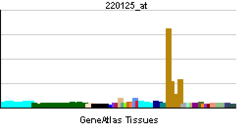DNAI1
Dynein intermediate chain 1, axonemal is a protein that in humans is encoded by the DNAI1 gene.[3][4]
The inner- and outer-arm dyneins, which bridge between the doublet microtubules in axonemes, are the force-generating proteins responsible for the sliding movement in axonemes. The intermediate and light chains, thought to form the base of the dynein arm, help mediate attachment and may also participate in regulating dynein activity. This gene encodes an intermediate chain dynein, belonging to the large family of motor proteins. Mutations in this gene result in abnormal ciliary ultrastructure and function associated with primary ciliary dyskinesia (PCD) and Kartagener syndrome. The DNAi1 gene (axonemal dyenin intermediate chain 1 gene 1) is a gene involved in the development of proper respiratory function, motility of spermatozoa, and asymmetrical organization of the viscera during embryogenesis. This gene affects these three very different aspects of development because all three are dependent on proper cilia function. DNAi1 codes for the development of cilia ultrastructure in the upper and lower respiratory tracts, spermatozoa flagellae, and nodal cilia (cilia of the primitive node). DNAi1 specifically encodes for an intermediate chain of the outer dyenin arm. Each dyenin arm of the ciliary axoneme has an inner and outer dyenin arm. A mutation in DNAi1 can lead to defective ciliary beating. A DNAi1 gene mutation accounts for 4-10% of all cases of primary ciliary dyskensia (PCD). The most frequent structural defect in cilia of PCD pateints are abnormal dyenin arms. A common mutation of DNAi1 leading to PCD is a hot-spot mutation in intron 1 of the gene. Mutations in coding or splicing are only found in 10% of PCD cases..[4]
References
- ↑ "Human PubMed Reference:".
- ↑ "Mouse PubMed Reference:".
- ↑ Pennarun G, Escudier E, Chapelin C, Bridoux AM, Cacheux V, Roger G, Clement A, Goossens M, Amselem S, Duriez B (Jan 2000). "Loss-of-function mutations in a human gene related to Chlamydomonas reinhardtii dynein IC78 result in primary ciliary dyskinesia". Am J Hum Genet. 65 (6): 1508–19. doi:10.1086/302683. PMC 1288361
 . PMID 10577904.
. PMID 10577904. - 1 2 "Entrez Gene: DNAI1 dynein, axonemal, intermediate chain 1".
External links
Further reading
- Guichard C, Harricane MC, Lafitte JJ, et al. (2001). "Axonemal dynein intermediate-chain gene (DNAI1) mutations result in situs inversus and primary ciliary dyskinesia (Kartagener syndrome).". Am. J. Hum. Genet. 68 (4): 1030–5. doi:10.1086/319511. PMC 1275621
 . PMID 11231901.
. PMID 11231901.
- Zariwala M, Noone PG, Sannuti A, et al. (2002). "Germline mutations in an intermediate chain dynein cause primary ciliary dyskinesia.". Am. J. Respir. Cell Mol. Biol. 25 (5): 577–83. doi:10.1165/ajrcmb.25.5.4619. PMID 11713099.
- Tai CY, Dujardin DL, Faulkner NE, Vallee RB (2002). "Role of dynein, dynactin, and CLIP-170 interactions in LIS1 kinetochore function.". J. Cell Biol. 156 (6): 959–68. doi:10.1083/jcb.200109046. PMC 2173479
 . PMID 11889140.
. PMID 11889140.
- Noone PG, Zariwala M, Sannuti A, et al. (2002). "Mutations in DNAI1 (IC78) cause primary ciliary dyskinesia.". Chest. 121 (3 Suppl): 97S. doi:10.1378/chest.121.3_suppl.97S. PMID 11893720.
- Strausberg RL, Feingold EA, Grouse LH, et al. (2003). "Generation and initial analysis of more than 15,000 full-length human and mouse cDNA sequences.". Proc. Natl. Acad. Sci. U.S.A. 99 (26): 16899–903. doi:10.1073/pnas.242603899. PMC 139241
 . PMID 12477932.
. PMID 12477932.
- Ficarro S, Chertihin O, Westbrook VA, et al. (2003). "Phosphoproteome analysis of capacitated human sperm. Evidence of tyrosine phosphorylation of a kinase-anchoring protein 3 and valosin-containing protein/p97 during capacitation.". J. Biol. Chem. 278 (13): 11579–89. doi:10.1074/jbc.M202325200. PMID 12509440.
- Ota T, Suzuki Y, Nishikawa T, et al. (2004). "Complete sequencing and characterization of 21,243 full-length human cDNAs.". Nat. Genet. 36 (1): 40–5. doi:10.1038/ng1285. PMID 14702039.
- Humphray SJ, Oliver K, Hunt AR, et al. (2004). "DNA sequence and analysis of human chromosome 9.". Nature. 429 (6990): 369–74. doi:10.1038/nature02465. PMC 2734081
 . PMID 15164053.
. PMID 15164053.
- Gerhard DS, Wagner L, Feingold EA, et al. (2004). "The status, quality, and expansion of the NIH full-length cDNA project: the Mammalian Gene Collection (MGC).". Genome Res. 14 (10B): 2121–7. doi:10.1101/gr.2596504. PMC 528928
 . PMID 15489334.
. PMID 15489334.
- Zariwala MA, Leigh MW, Ceppa F, et al. (2006). "Mutations of DNAI1 in primary ciliary dyskinesia: evidence of founder effect in a common mutation.". Am. J. Respir. Crit. Care Med. 174 (8): 858–66. doi:10.1164/rccm.200603-370OC. PMC 2648054
 . PMID 16858015.
. PMID 16858015.

 . PMID 10577904.
. PMID 10577904. . PMID 11231901.
. PMID 11231901. . PMID 11889140.
. PMID 11889140. . PMID 12477932.
. PMID 12477932. . PMID 15164053.
. PMID 15164053. . PMID 15489334.
. PMID 15489334. . PMID 16858015.
. PMID 16858015.